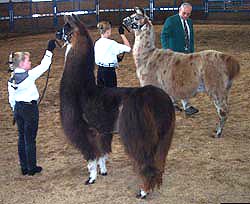| Home |
| Why Llamas? |
| Our Sires |
| Sale Animals |
| Our Services |
| Breeding Program |
| OFFF ILR Show |
| Awards |
| Our Products |
| Benton Co. 4-H |
| Our Ads |
| Consulting |
| About Us |
| Contact Us |
Llamas have many uses and markets, but many people own or raise them simply because they are wonderful animals. We are greeted at the gate by many of our llamas, and some are not satisfied until they have gently touched your face with their soft nose.
So you may be able to see where some of this love for llamas comes from. But, what about the stories you have heard? Aren't they nasty like camels? Don't they have other bad habits? There are many misconceptions about llamas, and most are just that (here is a link for a newspaper article that discussed misconceptions about llamas). Llamas are known for their lovely personalities and evoke many human responses. They are often taken into nursing homes to "communicate" with people who have not responded to people.
Llamas are certainly not nasty, even to other llamas. Indeed, llamas are truly a joy. Llama crias (baby llamas) are fantastically entertaining, bouncing about the pastures engaged in races with other crias. It is impossible not to smile while watching.
Llamas are used as breeding stock, wool producers, pack animals, pets, 4-H projects and even as sheep guardians, protecting sheep from predators such as coyotes in the western US and foxes in the UK.
Breeding stock: Llama breeding gives you a chance to experience the joy and excitement of crias (baby llamas). Among large animal species, llamas are quite easy to raise; they are feed efficient, so they don't eat much; they should graze on pasture and/or be feed grass hay rather than alfalfa, saving you money; they have fewer distocias.
Wool producers: With the breeder's attention, llama fiber can be on par with alpaca fiber and is highly prized. We have been focused on fiber for many years and the result is that most of our offspring have extremely fine fiber measuring in the range of 17 - 22 microns. This fiber is very soft and has a silky feel without the "prickle" that is common with lamb and sheep's wool.
Llamas as pack animals: In South America, llamas have always been used as work animals. It has been said that the Incan empire was built on the backs of llamas. Today, particularly in the arid west, llamas are highly prized as pack animals. Their padded feet do not destroy delicate mountain tundra and trails, and everything that a llama carries is for you. Llamas are browsers like deer and eat along the trail nibbling on leaves and grass. As members of the camelid family, they can go longer and further without water than other pack animals. Today, many dude ranches use llamas for mountain treks and champagne brunches.
Llamas as pets: The US llama herd originated with William Randolph Hearst at San Simeon. This multi-billionaire could afford anything he wanted, and had over 300 llamas grazing the grounds of his estate. He loved them for their beauty and tranquility. Today, gelded males are often used as pets. Llamas are easier to train than dogs and often much cheaper, costing less to buy and feed than many purebred dogs. Llamas can be ridden by small children and can also be trained to pull carts.
Llamas for 4-H: Llamas are gentle, smart and easy for children to work with. They cost little to maintain, and with some instruction, children can easily do the daily chores for the animal. The same animal can be used throughout the child's 4-H years creating a strong bond and mastering more difficult tasks each year. Llama training can be a wonderful learning experience for the child, and a llama is also a friend and companion. Here is a link to an older article with a few quotes from the girl on the bridge in the picture above.

The Alpaca and Llama Show Association (ALSA) sanctions llama shows that have three different age classes for youth 8 to 18 years old. Youth typically compete in three "performance" classes and a showmanship class. The three performance classes are obstacle (jumps, bridges, etc.), pack (obstacles with the llama carrying pack bags), and public relations ("obstacles" a llama would encounter in a public setting). Showmanship tests how well the handler is able to present their animal to the judge. Within four hours of Corvallis, there are at least five ALSA shows where youth can compete for awards with their llamas.
Llamas as sheep guardians: A single gelded male llama will bond with, and protect, sheep goats, mini horses and even calves by driving off potential predators such as coyotes and dogs. One of our customers reported that he was losing a lamb a night and a ewe once every four nights, reducing his profits to zero. After adding one of our males to his herd, his losses stopped completely.
Llamas are often much less expensive than guard dogs, and easier to train. They can easily be slipped into the herd, where they eat what the herd eats, and can guard effectively for over fifteen years.